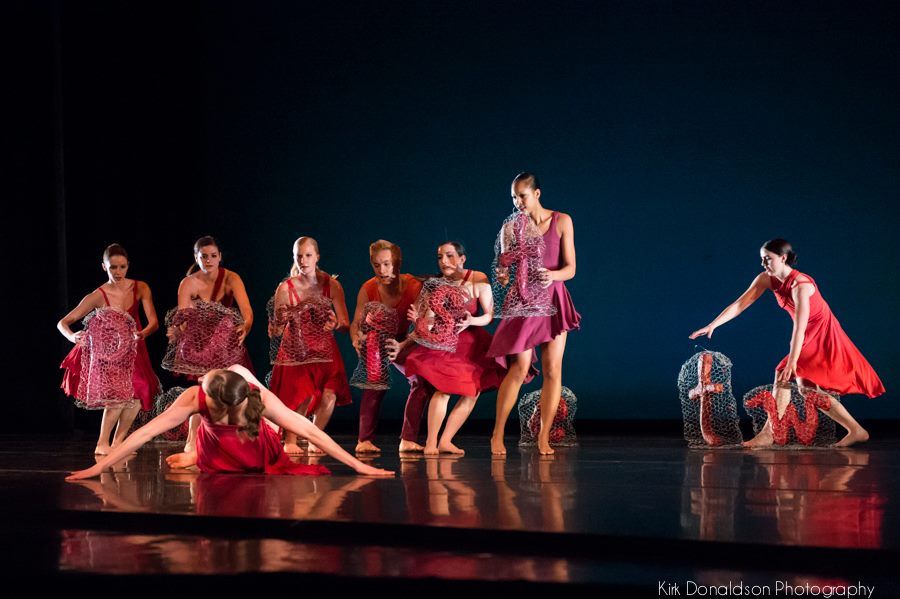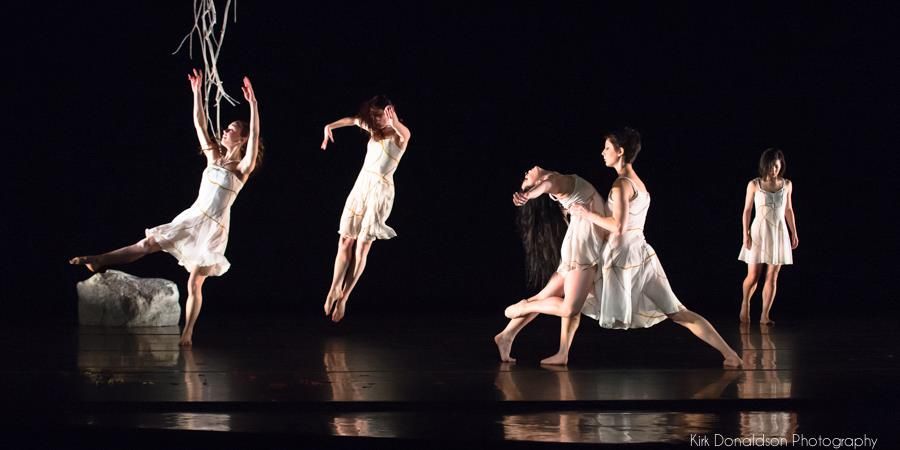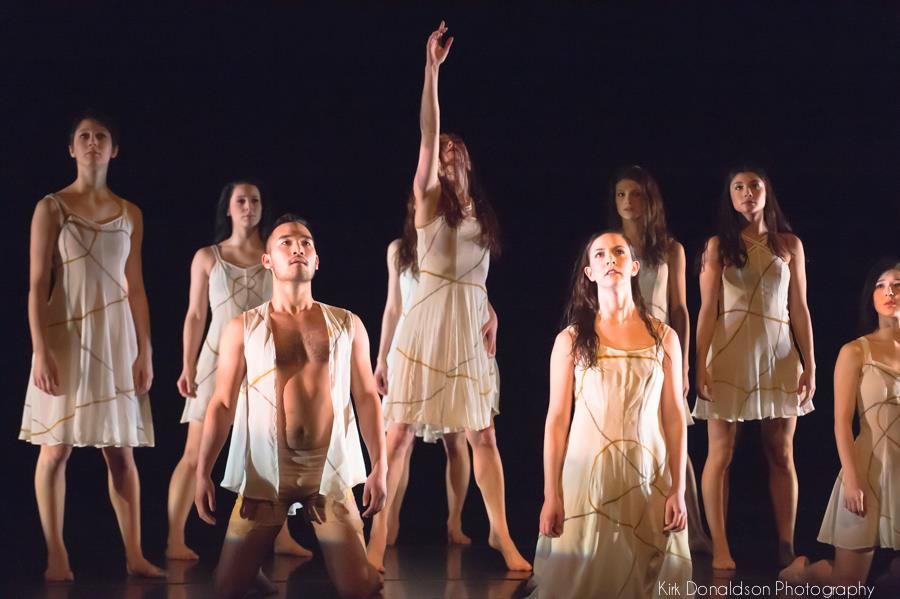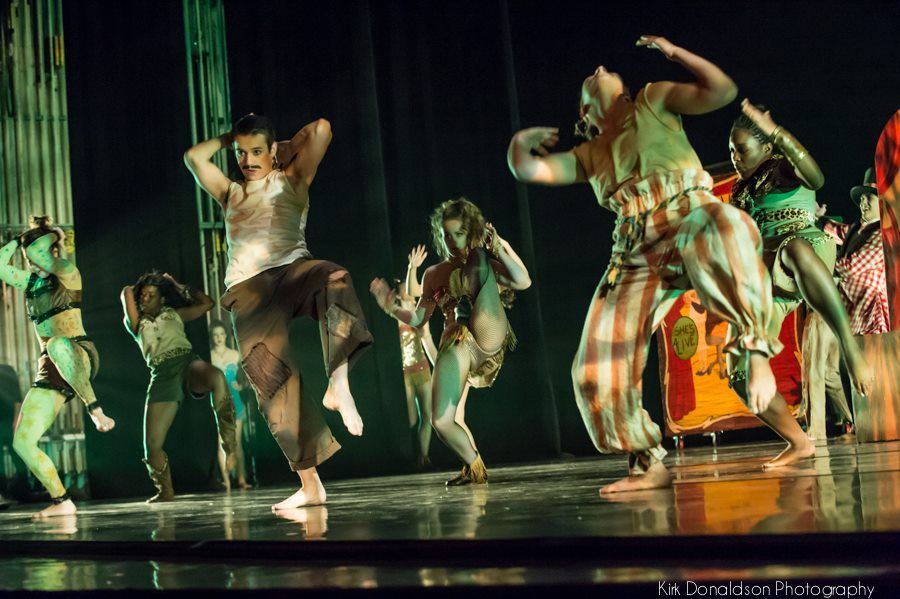Translation: A Modern Dance Event




Last weekend, The Department of Dance performed a stellar evening of movement at The Power Center. Inspired by Fall 2012’s Theme Semester “Translation,” the show shared the title as well as many exciting intellectual and artistic transpositions. The evening was divided into four pieces; the first three were original choreographies by U-M professors and the third was a celebrated piece by choreographer Bill. T. Jones.
The opening act was entitled “Hath Purest Wit.” Choreographed by Prof. Jessica Fogel, the piece involved a combination of music, poetry, spelling, and puzzle solving. While the audience was still settling into their seats, a dancer dressed in red graceful strutted onto the stage, encircling a pile of large, animated letters wrapped in chicken wire. As more bodies dressed in red entered the stage, the lights began to dim and suddenly it became clear that the show was starting. An robust man appeared, reciting excerpts from Lewis Carroll and Marcel Danesi about puzzle solving, cognition, and the satisfaction of” figuring it out.” As the dancers whirled and twisted and tossed and played with the with the life-size letters, they revealed a series of words that were all various permutations of the phrase “Hath Purest Wit.” It was incredible how many different combinations of phrases those few letters could produce! I wish I could recall them now- they’ve escaped my mind- but it was marvelous to see how versatile the words became and how each combination of letters dictated the quality of movement as the language changed.
The second piece was called “Aria Vitale” and was choreographed by Prof. Sandra Torijano. Also an original piece, this dance was a rhapsodic expression of the human emotions of vitality yearning, and sadness. Set to the operatic, orchestral music of Monteverdi, Villa-Lobos, Bach, and Iglesias, the piece seeped with passion and sorrow. The scene opened with a blackened stage punctuated by a drooping white tree branch. A male and female couple waltzed together, performing seamless partnering and acrobatics. With each shift in musical expression and lighting, the tone of the movement changed as well. The dance was fast, with lifts and leaps, and dancers entering and exiting from the wings at top speed. The set grew complex, incorporating costume changes, fluttering rose pedals, and towering metallic structures upon which the dancers climbed for the final pose. It was a gorgeous piece! I’ve never seen the Power Center stage become so transportive, etherial, and saturated with passion as I did in Aria Vitale.
After intermission, the tone of the show changed dramatically. “The Headless Woman” turned to the circus for inspiration. Choreographed by Prof. Amy Chavasse, the piece was translated from a newspaper story of a woman who joined the circus and enacted the freakish role of The Headless Woman. The backdrop of the stage included a video installation showing footage of a county fair. The music was equally reminiscent of a circus soundscape, with bells, whistles, accordions, and other dizzying sounds that took the audience for a rather wild ride. From glorified, scandalous female figures to gender-bending roles to tattooed contortionist types, the characters and their exaggerated bodily expressions became a ogle of “captivating misfits.”
Finally, the closing piece choreographed by Bill T. Jones was energetic, acrobatic, and very engaging to watch. In “D-Man in the Waters,” the dancers leapt and fell and dived across the stage, wearing an array of army-green inspired costumes. Because it was choreographed in the 80’s, I imagined the movement might be inspired by a commentary on the Vietnam War. However, through later reading I learned it was inspired by a friend of the choreographer who was fighting a loosing battle to cancer. The bright smiles on the dancers and the jolly, cooperative motion did not expressly communicate a personal inner battle. Knowing it’s impetus adds dimension to the already dynamic and demanding postures. The level of athleticism that was required of the bodies to perform the choreography was a masterpiece in and of itself.
Every year of college I have attended the annual Power Center-Dance Department performance. After four viewings, I must say that “Translation”was absolutely the best. The movement was infallible: so tight, so well rehearsed, and so technically impressive. I was struck by the strength and the grace of each dancer; each appeared collected as they bowed, seemingly unphased by the exertion they had just performed so artfully. I could hardly imagine the amount of effort that went from abstracting an idea for a Translation to presenting it in the Power Center wanted to hear more about the process of production so I asked inside sources.
About her experience of preparing for her role in Aria Vitale, senior Julia Smith-Eppsteiner (shown above) said:
Rehearsals started in September and Sandra worked differently every day. One day she would enter the studio and want to talk about a certain poem with the entire cast and the next day she might walk in, pull two people aside and start teaching them a movement phrase without saying anything. It was a lot of her sketching out ideas through improvising in front of us, seeing how that was interpreted in our body without time to practice the exact steps she showed–and then she would proceed in various ways depending on what the dancer presented back to her.
I am not one defined character throughout Aria Vitale but concepts of farewell, compassion, exhaustion, pain, celebration and vitality manipulate their way through a visual poem of relationships. The musical choices and genuine intimate relations between cast members are two aspects that really seemed to bring this work to life and surmount to its success on the Power Center stage.
This work was more challenging–and more rewarding–than anything I have rehearsed and performed at this University. It was physically difficult, specifically on my left leg, but also was a challenge in terms of yielding to the storytelling and allowing vulnerability to reign.
Did it resonate with my style as an artist? Not really, as I tend to choreograph and perform work that is more quirky, with sharper qualities, and sometimes text and humor play an important role. But dancing in Aria Vitale has been an incredible experience for me in my senior year that I am so thankful for because I am able to prove to myself and others that, yes, I can do “weird” dancing and that has its place and intrigue … but to perform such timeless, beautiful movement was exhilarating. It made me realize that I would love to professionally tour dance with a simliar quality as Aria Vitale–it allows the performers to indulge in risk and honesty, in every go-around.
And about her role in the Bill T. Jones piece, junior Nola Smith (also shown above) said:
Being a part of the re-staging of “D-Man in the Waters” was one of the most rewarding, fulfilling experiences I have been a part of in my time at Michigan. Germaul Barnes, the former Bill T. Jones dancer who set the work on us, was emphatic from the start of the process that the cast had to go beyond simply mimic-ing the previously choreographed steps– he told us that Bill T. Jones had provided a “framework” which each new cast of dancers could fill with their own interpretations and personalities. Because the piece is so physically demanding and has a lot of partnering, building trust among the dancers was a huge part of learning the dance. Although we only had about two and a half weeks to learn it, Germaul had us spend an entire three-hour rehearsal midway through the process sitting in a circle and telling each other about our experiences with loss and love. Having the opportunity to share our vulnerabilities with our fellow dancers made our support of each other during the dance even stronger. I think this experience also connected us to the conditions within the Bill T. Jones/Arnie Zane Dance Company when the work was being made in 1988-89– Bill T. Jones’s life and artistic partner Arnie Zane had just died from AIDS-related illness, and a dancer in the company, Demian Acquavella (to whom the piece is dedicated and named after), was also becoming sick from AIDS. Jones does not include this information in the program, only a quote by word-artist Jenny Holzer: “In a dream you saw a way to survive and you were full of joy.” Each audience member and each dancer can interpret this piece in a unique and personal way. Jones does not force the AIDS connection upon us, and allows the piece’s exuberance and vivaciousness to take hold (heightened, I think, by the incredible Mendelssohn music!). However, I hope that it gives anyone who watches it that “feeling of joy,” of rejoicing in life even when it is an uphill battle, of love and support and community and humanness– all feelings which have filled me up over the course of this beautiful experience.
I wish I could watch these performances again and again. The thing about original choreography is that it is so special, but so ephemeral. You have to be see it to believe it, and you can only catch it once.
(Photography courtesy of Kirk Donaldson)









